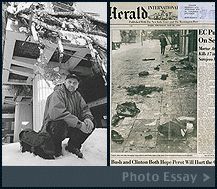|
|
|
When
I look at my photographs from the siege of Sarajevo and the war,
with few exceptions, they are sad, gloomy, and ugly – even
the good ones. That was our reality at the time. My favorite photo
from the war is the couple going to their wedding, walking down
a street lined with linen sheets to protect them from snipers. I
tried to capture a balance all the time. Everything happened at
once. In some of my photos, life goes on, while in others, a woman
lies in a pool of blood. Death is balanced by youth. I wanted to
show that there is love in this city, not just grenades and hospitals.
This was very calming for me.
Another important photograph for me is the photo of the man kissing
the ground next to a demolished mosque. I was in Misuca, approximately
thirty kilometers from Sarajevo.
|
 |
It
was the day before the Ramadan, or Bajram, and everyone thought that
this man was bowed in prayer. Actually he was kissing the ground,
not praying. He was born there; his house was across the street from
there, and he was a refugee returning to his home. The area was mostly
Serbian before the war – mixed actually – and he had returned
to see his ancestral land. It had been three, four, five years- as
long as the whole siege lasted. I’d seen him from my car. I used
a telephoto lens and started to shoot; I didn’t want to disturb
him and I had no idea how he would react to me. After that, I went
up and talked to him. He was crying, both happy and sad, but tears
of joy mostly…
The photo I am unfortunately best known for is of a man’s body
cut nearly in two after the infamous market bombing of August 1995.
I had been sitting at a café, about 200 yards away. I heard
an explosion and everything started to shake. At first I was afraid
to leave the café, so I just peeked out, brought my camera
to my eye, and walked straight ahead. That was the first time in my
life that I set the camera to fully automatic operation, focus, f-stop,
everything. I didn’t know what I was taking photos of until I
developed the film. Afterwards, I was in a state of shock. It’s
possible that if I’d put the camera down I’d have gone mad.
It’s
as if you have a certain capacity for pain that fills and fills until
you’re beyond the point of feeling it. Those photos, that wash
of blood on the asphalt – they’re the most horrifying photos
I ever took in my life. When I finally got back the film in all its
vivid colors and details, I was really horrified. Unfortunately, now
I’m known for these terrifying photographs. I’ve been photographing
for over twenty-five years now, and my whole career can be reduced
to two photographs taken during the war: the couple getting married
and the marketplace massacre – one worst and one best."
Sarajevo,
February 2000 |
 |
|
